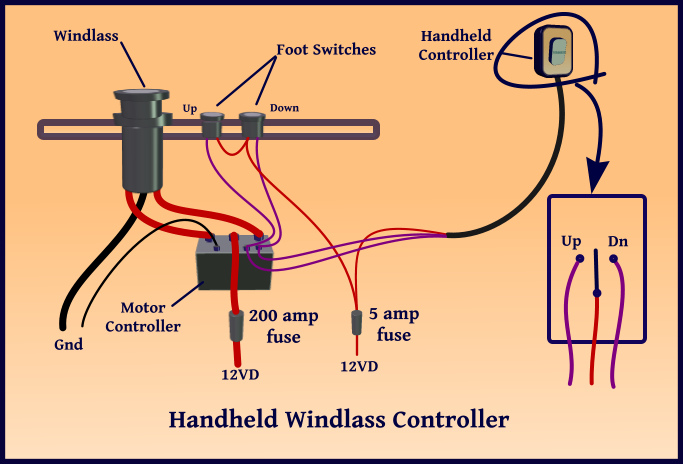The Blue View - Handheld Windlass Controller
/ In the last Blue View, Nine of Cups was in Suriname and I talked about installing foot switches for controlling a windlass, and using a windlass motor control module to reduce the current that passes through the switch contacts. Now we are 50 miles up the Essequibo River in Guyana, anchored off the small town of Bartica. In this BV, I want to address the usefulness of a handheld windlass controller and how to make one.
In the last Blue View, Nine of Cups was in Suriname and I talked about installing foot switches for controlling a windlass, and using a windlass motor control module to reduce the current that passes through the switch contacts. Now we are 50 miles up the Essequibo River in Guyana, anchored off the small town of Bartica. In this BV, I want to address the usefulness of a handheld windlass controller and how to make one.
Navigating the river was a challenge at times. The river has a strong tidal current, and it is necessary to wait until the current is flowing in the right direction before heading upriver. I know this is nothing new to you sailors who grew up sailing in waters with a large tidal swing, but for a guy who grew up in Colorado, it never ceases to amaze me when a river not only flows backwards six out of every twelve hours, but does so with great enthusiasm. The river is quite muddy, making it impossible to pick out shoals and rocks visually. In addition, the electronic charts are off by several hundred feet, and most of the channel markers have long since disappeared. Finally, the local fishermen use long nets, either stretched between poles stuck in the river or between an anchored float and their small dugout fishing boats. Our trip up the river had to correspond to the tidal swings, but had to be in daylight as well. We anchored offshore the first night, a few miles up the river on the second night, and made it to Bartica during the flood tide on the following day.
The river is quite muddy, and every time we haul the anchor, it and the chain come up coated with thick grey mud and clay. Our Boss anchor pulls up great gooey globs of the stuff. Rather than getting the mud all over the deck and down into the chain locker, Marcie uses the deck wash and hose to wash the mud off as the chain comes up. She leans over the bow pulpit, raises the anchor a few feet, and sprays the exposed chain until the mud is washed off, then repeats the process. Unfortunately, in this position, she can't reach the windlass foot switch with her toe.
Our handheld windlass controller makes her job easier and faster. She can lean over the bow pulpit with the hose sprayer in one hand, while controlling the windlass with the other. When we have a lot of chain out and the mud is thick, raising the anchor might take a half hour using the foot switches, while the handheld controller might knock ten minutes off the process. Notice that we still have the foot switches mounted in the deck. If either the foot switch or the handheld controller stops working, the other remains as a backup.
The handheld controller is nothing more than a SPDT rocker switch mounted in a small palm-sized enclosure and connected to the windlass motor control module with a long, three conductor cable. The cable is long enough to reach from the motor controller to the bow. One switch contact connects 12vdc to the 'Up' connection on the motor control module and the other contact connects 12vdc to the 'Down' connection. Since the current required for these connections is less than 5 amps,(typically 3 amps) for our Lofrans windlass motor control module, the switches and wiring can both be small. I used a waterproof Cole Hersee “Contura” rocker switch from West Marine (C-H Pt. No. 58332-22-BP). I store the handheld controller in a small bin mounted in the forepeak locker when not in use to keep it out of the elements for most of its life.
In the next Blue View, I'll talk about our chain counter. It's not difficult to add a small display and some circuitry to the handheld controller so that Marcie can see how much chain is in the water as we drop or raise anchor. Marcie may disagree, but for you fellow sailor-geeks out there, it just doesn't get much more entertaining than that.





